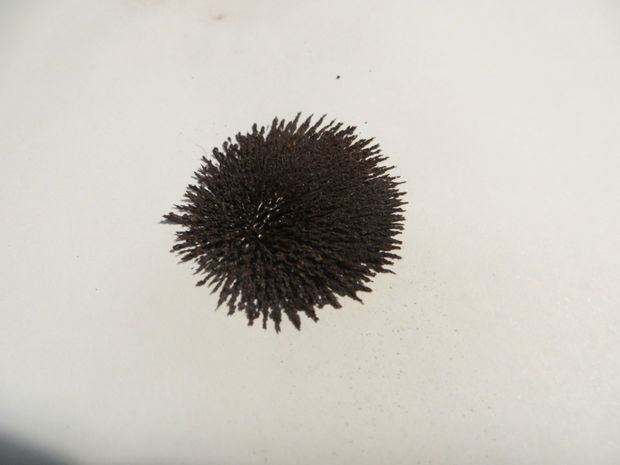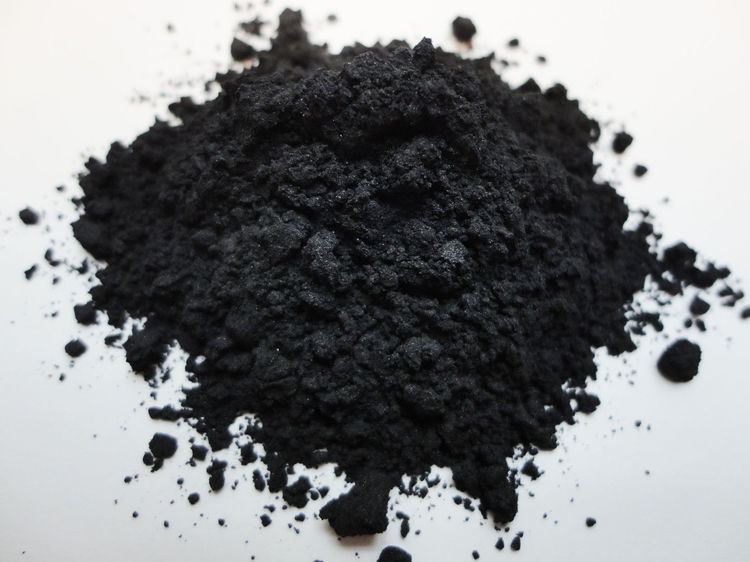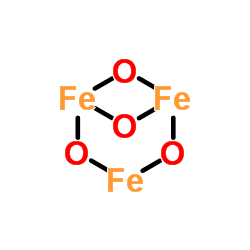Formula FeO·Fe2O3 Density 5.17 g/cm³ Appearance solid black powder | Molar mass 231.533 g/mol Melting point 1,597 °C | |
 | ||
ChemSpider ID 17215625 Boiling point 2,623 °C (4,753 °F; 2,896 K) IUPAC name iron(II) iron(III) oxide Other names ferrous ferric oxide, ferrosoferric oxide, iron(II,III) oxide, magnetite, black iron oxide, lodestone, rust, iron(II) diiron(III) oxide Refractive index (nD) 2.42 Std enthalpy of formation (ΔfH⦵298) -1120.89 kJ·mol−1 CAS Number 1317-61-9 3D model (JSmol) Interactive image ChEBI CHEBI:50821 ChEMBL ChEMBL1201867 ChemSpider 17215625 ECHA InfoCard 100.013.889 PubChem CID 16211978 UNII XM0M87F357 CompTox Dashboard (EPA) DTXSID5029639 Similar Iron(II) oxide, Copper(II) oxide, Aluminium oxide | ||
Iron ii iii oxide
Iron(II,III) oxide is the chemical compound with formula Fe3O4. It occurs in nature as the mineral magnetite. It is one of a number of iron oxides, the others being iron(II) oxide (FeO), which is rare, and iron(III) oxide (Fe2O3) also known as hematite. It contains both Fe2+ and Fe3+ ions and is sometimes formulated as FeO ∙ Fe2O3. This iron oxide is encountered in the laboratory as a black powder. It exhibits permanent magnetism and is ferrimagnetic, but is sometimes incorrectly described as ferromagnetic. Its most extensive use is as a black pigment which is synthesised rather than being extracted from the naturally occurring mineral as the particle size and shape can be varied by the method of production.
Contents

Preparation

Under anaerobic conditions, ferrous hydroxide (Fe(OH)2) can be oxidized by water to form magnetite and molecular hydrogen. This process is described by the Schikorr reaction:

The well-crystallized magnetite (Fe3O4) is thermodynamically more stable than the ferrous hydroxide (Fe(OH)2 ).

Magnetite can be prepared in the laboratory as a ferrofluid in the Massart method by mixing iron(II) chloride and iron(III) chloride in the presence of sodium hydroxide. Magnetite can also be prepared by the chemical co-precipitation in presence of ammonia, which consist in a mixture of a solution 0.1 M of FeCl3·6H2O and FeCl2·4H2O with mechanic agitation of about 2000 rpm. The molar ratio of FeCl3:FeCl2 can be 2:1; heating this solution at 70 °C, and immediately the speed is elevated to 7500 rpm and adding quickly a solution of NH4OH (10 volume %), immediately a dark precipitate will be formed, which consists of nanoparticles of magnetite. In both cases, the precipitation reaction rely on a quick transformation of acidic hydrolyzed iron ions into the spinel iron oxide structure, by hydrolysis at elevated pH values (above ca. 10).

Considerable efforts has been devoted towards controlling the particle formation process of magnetite nanoparticles due to the challenging and complex chemistry reactions involved in the phase transformations prior to the formation of the magnetite spinel structure. Magnetite particles are of interests in bioscience applications such as in magnetic resonance imaging (MRI) since iron oxide magnetite nanoparticles represent a non-toxic alternative to currently employed gadolinium-based contrast agents. However, due to lack of control over the specific transformations involved in the formation of the particles, truly superparamagnetic particles have not yet been prepared from magnetite, i.e. magnetite nanoparticles that completely lose their permanent magnetic characteristic in the absence of an external magnetic field (which by definition show a coercivity of 0 A/m). The smallest values currently reported for nanosized magnetite particles is Hc = 8.5 A m−1, whereas the largest reported magnetization value is 87 Am2 kg−1 for synthetic magnetite.

Pigment quality Fe3O4, so called synthetic magnetite, can be prepared using processes that utilise industrial wastes, scrap iron or solutions containing iron salts (e.g. those produced as by-products in industrial processes such as the acid vat treatment (pickling) of steel):
Reduction of Fe2O3 with hydrogen:
3Fe2O3 + H2 → 2Fe3O4 +H2OReduction of Fe2O3 with CO:
3Fe2O3 + CO → 2Fe3O4 + CO2Production of nano-particles can be performed chemically by taking for example mixtures of FeII and FeIII salts and mixing them with alkali to precipitate colloidal Fe3O4. The reaction conditions are critical to the process and determine the particle size.
Reactions
Reduction of magnetite ore by CO in a blast furnace is used to produce iron as part of steel production process:
Controlled oxidation of Fe3O4 is used to produce brown pigment quality γ-Fe2O3 (maghemite):
More vigorous calcining (roasting in air) gives red pigment quality α-Fe2O3 (hematite):
Structure
Fe3O4 has a cubic inverse spinel structure which consists of a cubic close packed array of oxide ions where all of the Fe2+ ions occupy half of the octahedral sites and the Fe3+ are split evenly across the remaining octahedral sites and the tetrahedral sites.
Both FeO and γ-Fe2O3 have a similar cubic close packed array of oxide ions and this accounts for the ready interchangeability between the three compounds on oxidation and reduction as these reactions entail a relatively small change to the overall structure. Fe3O4 samples can be non-stoichiometric.
The ferrimagnetism of Fe3O4 arises because the electron spins of the FeII and FeIII ions in the octahedral sites are coupled and the spins of the FeIII ions in the tetrahedral sites are coupled but anti-parallel to the former. The net effect is that the magnetic contributions of both sets are not balanced and there is a permanent magnetism.
Properties
Fe3O4 is ferrimagnetic with a Curie temperature of 858 K. There is a phase transition at 120K, the so-called Verwey transition where there is a discontinuity in the structure, conductivity and magnetic properties. This effect has been extensively investigated and whilst various explanations have been proposed, it does not appear to be fully understood.
Fe3O4 is an electrical conductor with a conductivity significantly higher (X 106) than Fe2O3, and this is ascribed to electron exchange between the FeII and FeIII centres.
Uses
Fe3O4 is used as a black pigment and is known as C.I pigment black 11 (C.I. No.77499).
Fe3O4 is used as a catalyst in the Haber process and in the water gas shift reaction. The latter uses an HTS (high temperature shift catalyst) of iron oxide stabilised by chromium oxide. This iron-chrome catalyst is reduced at reactor start up to generate Fe3O4 from α-Fe2O3 and Cr2O3 to CrO3.
Nano particles of Fe3O4 are used as contrast agents in MRI scanning.
Ferumoxytol, also known as Feraheme and Rienso, is an intravenous Fe3O4 preparation for treatment of anemia resulting from chronic kidney disease. Ferumoxytol is manufactured and globally distributed by AMAG Pharmaceuticals.
Along with sulfur and aluminium, it is an ingredient in a specific type of thermite useful for cutting steel.
Bluing is a passivation process that produces a layer of Fe3O4 on the surface of steel to protect it from rust.
Biological occurrence
Magnetite has been found as nano-crystals in magnetotactic bacteria (42-45 nm) and in homing pigeon beak tissue
